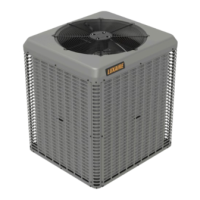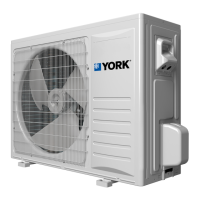Figure 8: Correct bulb location
Evacuation
Evacuate the system to 500 microns or less. If a leak is
suspected, leak test with dry nitrogen to locate the leak.
Repair the leak and test again.
To verify that the system has no leaks, close the valve to
the vacuum pump suction to isolate the pump and hold
the system under vacuum. Watch the micron gauge for
a few minutes. If the micron gauge indicates a steady
and continuous rise, it is an indication of a leak. If the
gauge shows a rise, then levels off after a few minutes
and remains fairly constant, it is an indication the system
is leak free but still contains moisture and may require
further evacuation if the reading is above 500 microns.
System charge
CAUTION
If a field-installed device is placed in the inner-
connecting refrigerant lines that can store a significant
refrigerant charge (for example, a refrigerant mass
flow meter or a liquid receiver), the unit may not
perform as designed. If such a performance-affecting
device is installed and it is possible to check the
unit in heating mode, the unit pressures should be
confirmed in heating mode. See the heating charging
charts located in this installation manual.
CAUTION
Refrigerant charging should only be carried out by a
licensed qualified air conditioning contractor.
To ensure that the unit performs at the published levels,
it is important to determine the indoor airflow and add
refrigerant charge accordingly.
Measuring indoor airflow
About this task:
To determine the rated airflow for a specific match,
refer to the technical literature available at http://
www.simplygettingthejobdone.com. When attempting to
match this airflow, select the lowest possible speed tap,
measure the actual flow, and adjust as necessary.
To measure actual airflow, it is not an acceptable method
to just check the jumper pin setting tables and assume 0.5
in. W.C total external static pressure.
To determine indoor airflow, follow these steps:
1. On a gas furnace or single-piece air handler,
measure the static pressure with a manometer
between the filter and return air opening of the
indoor equipment. On a modular air handler,
measure the return air static pressure between the
indoor coil and entering air side of the modular air
handler.
2. Perform a or b.
a. On a single-piece or modular air handler, take a
second reading in the supply air ductwork leaving the
indoor equipment.
b. On a gas furnace, take a second reading after the heat
exchanger, but before the indoor coil.
3. Add the negative return static to the positive
supply static to determine the total system static
pressure. Treat the negative return static as a
positive pressure (even though it is a negative
reading). If there is static pressure on the blower
return (for example, -0.1 in. W.C.), add it to a supply
static (0.4 in. W.C.) that equals the total system
static pressure (0.5 in. W.C.).
4. Compare this value to the indoor blower
performance charts, ensuring air flow is between
350 CFM to 450 CFM per ton of cooling.
Charging the unit
CAUTION
Always charge in liquid form. Take care not to slug the
compressor.
The factory charge in the outdoor unit includes enough
charge for the unit, 15 ft (4.6 m) of refrigerant piping, and
the smallest indoor coil or air handler match-up. Some
indoor coil or air handler matches may require additional
charge.
Installation Manual: R-410A Outdoor Split-System Heat Pump - YH2F, THF2, RHP150 Series 13
Johnson Controls Ducted Systems

